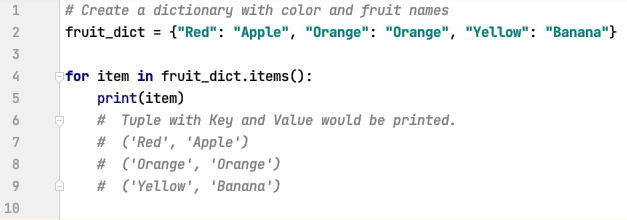

The way that we accomplished this is by first converting our value to a tuple. We can see here that our tuple had a value appended to it. Let’s see what this looks like: # Appending to a tuple with concatenation We can use the + operator to concatenate the value onto our tuple. Let’s say that we have one tuple (1, 2, 3) and we want to append the value 4 to it. The way that this works is by using the + operator, which allows us to combine two tuples. In fact, when we do this, we actually create a new tuple, even if we apply it to the same variable as before. While Python tuples don’t offer a dedicated method to append values, we can emulate appending to a tuple by using tuple concatenation. Append to a Python Tuple Using Tuple Concatenation Want to learn more about Python for-loops? Check out my in-depth tutorial that takes your from beginner to advanced for-loops user! Want to watch a video instead? Check out my YouTube tutorial here.

TUPLE UNPACKING PYTHON HOW TO
So how do we actually append to a Python tuple? In the Next section, you’ll learn how to use Python to append to a tuple by using tuple concatenation. # Returns: AttributeError: 'tuple' object has no attribute 'append' Let’s see what happens when we try to apply this to our tuple. We can see that this raises a TypeError error. # Returns: TypeError: 'tuple' object does not support item assignment Now, let’s see what happens when we try to modify the third item in our tuple. We can see here that by printing out the type of our object that this returned. We’ll instantiate a new tuple with a number of different values and then print out the type of the object using the type() function. Let’s see what creating a tuple looks like in Python. Because of this, when we refer to appending to a tuple in Python throughout this tutorial, we actually mean creating a new object which appends a value to an existing tuple. When we want to append a value to something, this in fact involves changing (or mutating) that item. This, of course, presents a problem if we want to use Python to append to a tuple. What does immutable mean? The Python documentation defines immutable as having a fixed value and not able to be changed. All of this probably makes tuples sound very similar to Python lists, but they have one significant difference: they are immutable.

Lists are also ordered and indexed, meaning that we can access a tuples’ items using its index position. Because they are container data types, they can hold different items and allow items of different data types, meaning that they are heterogeneous. They are generally created using regular parentheses (). Python tuples are one of the main container data structures available within Python. Modify a Tuple’s Contents by Appending a Value.Append to a Python Tuple with Tuple Unpacking.Append to a Python Tuple by List Conversion.Append to a Python Tuple Using Tuple Concatenation.Then the variable first will be assigned ‘m’, the variable last will be assigned ‘a’, and the variable middle will just be an empty list since there are no other values to assign to it. If there are not enough values to unpack for the mandatory variables, we will get a ValueError.įor example, if we used the following assignment instead: first, *middle, last = ‘ma' The middle variable, due to using the * or unpacking operator, can have any number of values, including zero. Note: The first and last variables above are called mandatory variables, as they must be assigned concrete values. And the variable middle will contain all the letters between ‘M’ and ‘l’ in the form of a list. The last letter, ‘l’, is assigned to the variable last. As such, the first letter of ‘Michael’ is assigned to the variable first, which would be ‘M’ in this case. The values on the right side of the assignment operator will be assigned to the variables on the left depending on their relative position in the iterable object. We can do so as follows: first, *middle, last = nameĪnd that’s it! Since name is a string, and strings are iterable objects, we can unpack them. Let’s say that we have a string assigned to the variable name: name = ‘Michael’Īnd we want to break this name up into 3 parts, with the first letter being assigned to a variable, the last letter being assigned to another variable, and everything in the middle assigned to a third variable.


 0 kommentar(er)
0 kommentar(er)
